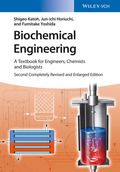Biochemical Engineering
A Textbook for Engineers, Chemists and Biologists

2. Edition March 2015
XXII, 304 Pages, Softcover
200 Pictures
20 tables
Textbook
Short Description
The textbook is a welcome introduction to the field, providing numerous questions & answers and applied examples, whilst covering all essential topics: bioreactors, heat & mass transfer, separation processes and various industrial applications.
Buy now
Price: 79,90 €
Price incl. VAT, excl. Shipping
Euro prices for Wiley-VCH and Ernst & Sohn titles are only valid for Germany. In EU countries, local VAT applies. Postage will be charged.
Completely revised, updated, and enlarged, this second edition now contains a subchapter on biorecognition assays, plus a chapter on bioprocess control added by the new co-author Jun-ichi Horiuchi, who is one of the leading experts in the field.
The central theme of the textbook remains the application of chemical engineering principles to biological processes in general, demonstrating how a chemical engineer would address and solve problems. To create a logical and clear structure, the book is divided into three parts. The first deals with the basic concepts and principles of chemical engineering and can be read by those students with no prior knowledge of chemical engineering. The second part focuses on process aspects, such as heat and mass transfer, bioreactors, and separation methods. Finally, the third section describes practical aspects, including medical device production, downstream operations, and fermenter engineering. More than 40 exemplary solved exercises facilitate understanding of the complex engineering background, while self-study is supported by the inclusion of over 80 exercises at the end of each chapter, which are supplemented by the corresponding solutions.
An excellent, comprehensive introduction to the principles of biochemical engineering.
Nomenclature
PART I: Basic Concepts and Principles
INTRODUCTION
Background and Scope
Dimensions and Units
Intensive and Extensive Properties
Equilibria and Rates
Batch vs. Continuous Operation
Material Balance
Energy Balance
ELEMENTA OF PHYSICAL TRANSFER PROCESSES
Introduction
Heat Conduction and Molecular Diffusion
Fluid Flow and Momentum Transfer
Laminar vs. Turbulent Flow
Transfer Phenomena in Turbulent Flow
Film Coefficients of Heat and Mass Transfer
CHEMICAL AND BIOCHEMICAL KINETICS
Introduction
Fundamental Reaction Kinetics
CELL KINETICS
Introduction
Cell Growth
Growth Phases in Batch Culture
Factors Affecting Rates of Cell Growth
Cell Growth in Batch Fermentors and Continuous Stirred Tank Fermentor (CSTF)
PART II: Unit Operations and Apparatus for Bio-Systems
HEAT TRANSFER
Introduction
Overall Coefficients U and Film Coefficients h
Mean Temperature Difference
Estimation of Film Coefficients h
Estimation of Overall Coefficients U
MASS TRANSFER
Introduction
Overall Coefficients K and Film Coefficients k of Mass Transfer
Types of Mass Transfer Equipment
Models for Mass Transfer at the Interface
Liquid Phase Mass Transfer with Chemical Reactions
Correlations for Film Coefficients of Mass Transfer
Performance of Packed Column
BIOREACTORS
Introduction
Some Fundamental Concepts
Bubbling Gas-Liquid Reactors
Mechanically Stirred Tanks
Gas Dispersion in Stirred Tanks
Bubble Columns
Airlift Reactors
Packed-Bed Reactors
Microreactors
MEMBRANE PROCESSES
Introduction
Dialysis
Ultrafiltration
Microfiltration
Reverse Osmosis
Membrane Modules
CELL-LIQUID SEPARATION AND CELL DISRUPTION
Introduction
Conventional Filtration
Microfiltration
Centrifugation
Cell Disruption
STERILIZATION
Introduction
Kinetics of Thermal Death of Cells
Batch Heat Sterilization of Culture Media
Continuous Heat Sterilization of Culture Media
Sterilizing Filtration
ADSORPTION AND CHROMATOGRAPHY
Introduction
Equilibria in Adsorption
Rates of Adsorption into Adsorbent Particles
Single- and Multi-Stage Processes for Adsorption
Adsorption in Fixed Beds
Separation by Chromatography
Biorecognition Assay
PART III: Practical Aspects in Bioengineering
FERMENTOR ENGINEERING
Introduction
Stirrer Power Requirements for Non-Newtonian Liquids
Heat Transfer in Fermentors
Gas-Liquid Mass Transfer in Fermentors
Criteria for Scaling-Up Fermentors
Modes of Fermentor Operation
Fermentors for Animal Cell Culture
INSTRUMENTATION AND CONTROL OF BIOPROCESSES
Introduction
Instrumentation of Bioprocesses
Control of Bioprocesses
Advanced Control of Bioprocesses
DOWNSTREAM OPERATIONS IN BIOPROCESSES
Introduction
Separation of Microorganisms by Filtration and Microfiltration
Separation by Chromatography
Separation in Fixed Beds
Sanitation in Downstream Processes
MEDICAL DEVICES
Introduction
Blood and Its Circulation
Oxygenation of Blood
Artificial Kidney
Bioartificial Liver
Appendix
Index
Prof. Jun-ichi Horiuchi is Director of the Instrumental Analysis Center at the Kitami Institute of Technology (Japan) since 2010. He obtained his Master degree in Engineering from Hokkaido University and thereafter went to the Science University of Tokyo, where he received his PhD in biotechnology in 1995. Afterwards he spent several years as research engineer at Toyo Engineering Corporation, before he became Professor at the Kitami Institute of Technology in 1998. Prof. Horiuchis research interests are in the field of bioprocess control and optimization and up to now he published over 60 peer reviewed jounal contributions, 12 patents and 9 book contributions.
Prof. em. Fumitake Yoshida was one of the world's most respected chemical engineers. Most recently he was professor emeritus of chemical engineering at Kyoto University and well beyond his retirement he continued to be a visiting lecturer at universities around the world. He conducted research on various mass transfer operations, gas-liquid systems in particular, investigating their applications in bioengineering and medical technology. Yoshida received his BS and PhD degrees in engineering from Kyoto University. Among his many awards and citations was election to the National Academy of Engineering of the United States in 1979 for his leadership in chemical, biochemical, and biomedical engineering in Japan.


